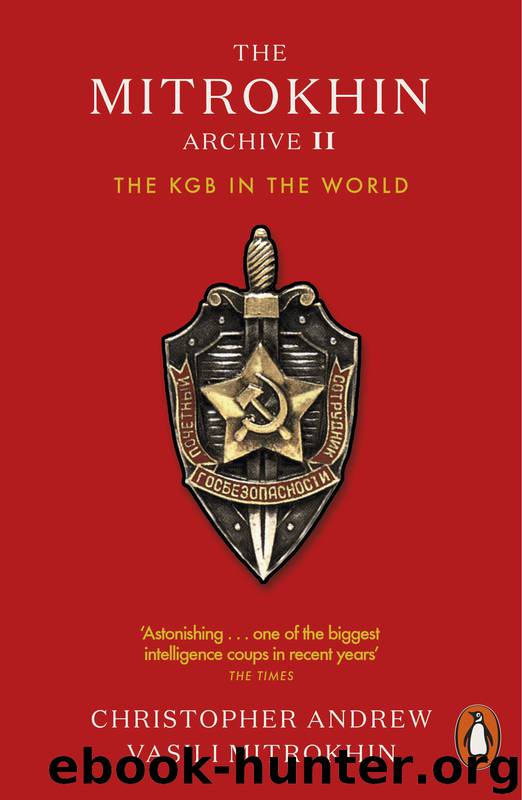The Mitrokhin Archive II by Christopher Andrew & Vasili Mitrokhin

Author:Christopher Andrew & Vasili Mitrokhin
Language: eng
Format: epub
Publisher: Penguin Books Ltd
Published: 2013-03-03T16:00:00+00:00
17
The Special Relationship with India
Part 1: The Supremacy of the Indian National Congress
The Third World country on which the KGB eventually concentrated most operational effort during the Cold War was India. Under Stalin, however, India had been regarded as an imperialist puppet. The Great Soviet Encyclopedia dismissed Mohandas ‘Mahatma’ Gandhi, who led India to independence in 1947, as ‘a reactionary … who betrayed the people and helped the imperialists against them; aped the ascetics; pretended in a demagogic way to be a supporter of Indian independence and an enemy of the British; and widely exploited religious prejudice’.1 Despite his distaste for Stalinist attacks Jawaharlal Nehru, the first Prime Minister of independent India, ‘had no doubt that the Soviet revolution had advanced human society by a great leap and had lit a bright flame which could not be smothered’. Though later eulogized by Soviet writers as ‘a leader of international magnitude’ who ranked ‘among the best minds of the twentieth century’,2 Nehru was well aware that until Stalin’s death in 1953 he, like Gandhi, was regarded as a reactionary. During the early years of Indian independence, secret correspondence from Moscow to the Communist Party of India (CPI) was frequently intercepted by the Intelligence Branch (IB) in New Delhi (as it had been when the IB was working for the British Raj). According to the head of the IB, B. N. Mullik, until the early 1950s ‘every instruction that had issued from Moscow had expressed the necessity and importance [for] the Indian Communist Party to overthrow the “reactionary” Nehru Government’.3 Early in 1951 Mullik gave Nehru a copy of the latest exhortations from Moscow to the CPI, which contained a warning that they must not fall into government hands. Nehru ‘laughed out loud and remarked that Moscow apparently did not know how smart our Intelligence was’.4
Neither Nehru nor the IB, however, realized how thoroughly the Indian embassy in Moscow was being penetrated by the KGB, using its usual varieties of the honey trap. The Indian diplomat PROKHOR was recruited, probably in the early 1950s, with the help of a female swallow, codenamed NEVEROVA, who presumably seduced him. The KGB was clearly pleased with the material which PROKHOR provided, which included on two occasions the embassy codebook and reciphering tables, since in 1954 it increased his monthly payments from 1,000 to 4,000 rupees.5 Another Indian diplomat, RADAR, was recruited in 1956, also with the assistance of a swallow, who on this occasion claimed (probably falsely) to be pregnant.6 A third KGB swallow persuaded a cipher clerk in the Indian embassy, ARTUR, to go heavily into debt in order to make it easier to compromise him. He was recruited as an agent in 1957 after being trapped (probably into illegal currency dealing) by a KGB officer posing as a black-marketeer.7 As a result of these and other penetrations of the embassy, Soviet codebreakers were probably able to decrypt substantial numbers of Indian diplomatic communications.8
As KGB operations in India expanded during the 1950s and 1960s,
Download
This site does not store any files on its server. We only index and link to content provided by other sites. Please contact the content providers to delete copyright contents if any and email us, we'll remove relevant links or contents immediately.
| Elections & Political Process | Ideologies & Doctrines |
| International & World Politics | Political Science |
| Public Affairs & Policy | Specific Topics |
| United States |
The Secret History by Donna Tartt(17551)
The Social Justice Warrior Handbook by Lisa De Pasquale(11725)
Thirteen Reasons Why by Jay Asher(8153)
This Is How You Lose Her by Junot Diaz(6156)
Weapons of Math Destruction by Cathy O'Neil(5475)
Zero to One by Peter Thiel(5183)
The Myth of the Strong Leader by Archie Brown(4990)
Beartown by Fredrik Backman(4926)
How Democracies Die by Steven Levitsky & Daniel Ziblatt(4710)
The Fire Next Time by James Baldwin(4690)
Promise Me, Dad by Joe Biden(4681)
Stone's Rules by Roger Stone(4629)
100 Deadly Skills by Clint Emerson(4419)
Rise and Kill First by Ronen Bergman(4300)
A Higher Loyalty: Truth, Lies, and Leadership by James Comey(4276)
The David Icke Guide to the Global Conspiracy (and how to end it) by David Icke(4157)
The Farm by Tom Rob Smith(4123)
Secrecy World by Jake Bernstein(4077)
The Doomsday Machine by Daniel Ellsberg(4003)
